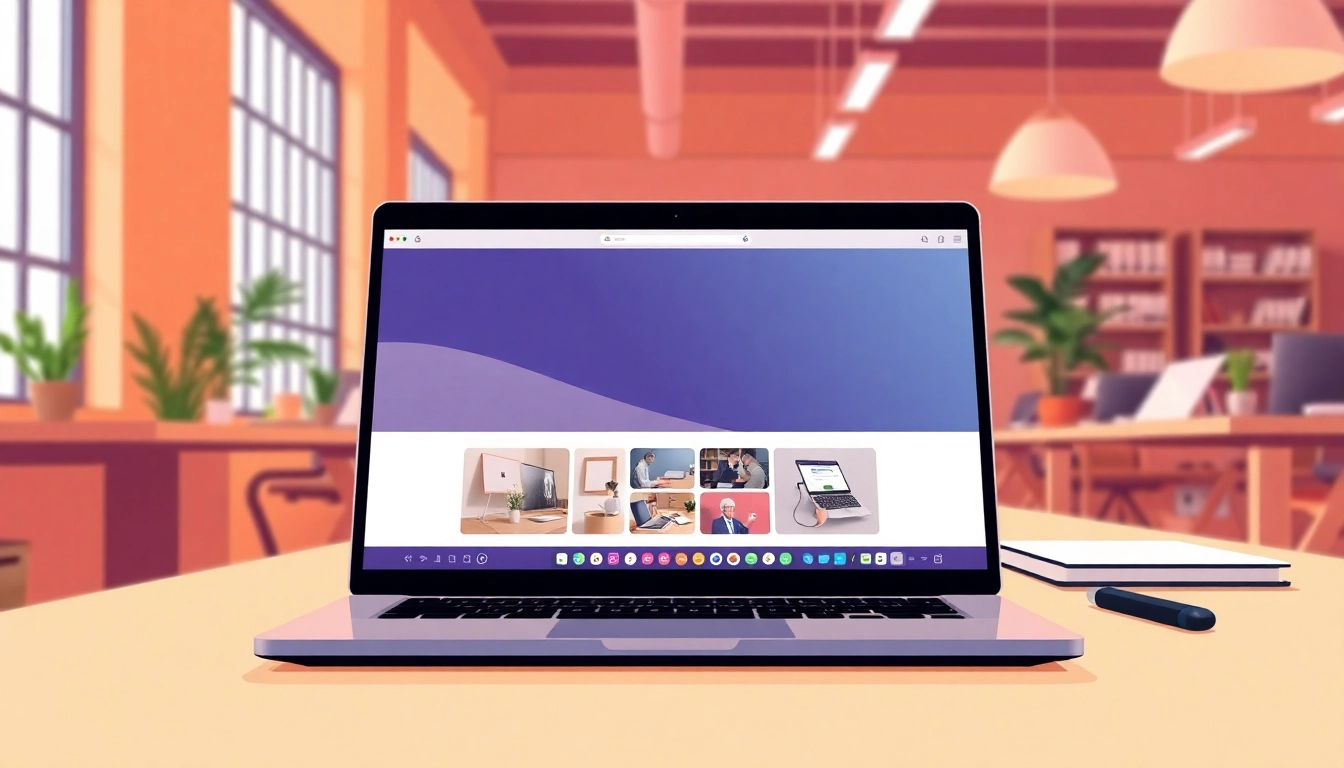Understanding Web Development Basics
Web development is an expansive term encompassing all the tasks related to creating, building, and maintaining websites and web applications. It generally involves a mix of front-end development—what users interact with—and back-end development, which handles the server-side operations. Understanding web development is crucial for anyone aspiring to dive into the digital realm, whether they are freelancers, aspiring developers, or business owners looking to establish a strong online presence.
What is Web Development?
The term “web development” broadly covers various tasks related to the building and maintenance of websites. It includes everything from coding, scripting, and network configuration to content management and web design. In essence, web development is about making a website functional, user-friendly, and aesthetically appealing. The process can be as simple as building a static webpage, which displays fixed content, or as complex as developing an interactive web application requiring constant data updates.
Key Components of Web Development
Web development consists of several key components, each contributing to the overall success of a website or web application. These components include:
- Front-End Development: This relates to what users see and interact with on their browsers—HTML, CSS, and JavaScript are primarily used here.
- Back-End Development: This involves the server side of a web application, including server configuration, databases, and application logic. Back-end developers often utilize languages like Python, Ruby, PHP, or Node.js.
- Full-Stack Development: Full-stack developers are adept at both front-end and back-end technologies and can consequently oversee an entire project.
- Web Design: While developers focus on code, web designers concentrate on the aesthetics and usability of a site, including layout, color schemes, and typography.
- Content Management Systems (CMS): These systems help users create and manage digital content. Popular CMS platforms include WordPress, Drupal, and Joomla.
Types of Web Development: Front-end vs Back-end
Understanding the distinction between front-end and back-end development is crucial. Front-end development (also known as client-side development) focuses on the user interface (UI) and user experience (UX). It involves designing web pages and ensuring they are responsive and visually appealing across devices.
Conversely, back-end development (or server-side development) handles the logic and data behind the scenes. This includes database interactions, server functionality, and application logic. A well-built back-end is essential for providing a seamless user experience.
Essential Skills for Web Development
To thrive in the web development field, individuals must acquire a robust set of skills reflecting both technical abilities and design principles. Below is an overview of these essential skills.
Programming Languages and Frameworks
Some of the most crucial programming languages and frameworks include:
- HTML (HyperText Markup Language): The backbone of web pages, HTML provides the basic structure.
- CSS (Cascading Style Sheets): CSS styles the layout and presentation of HTML elements, allowing for customization of fonts, colors, and spacing.
- JavaScript: A powerful scripting language that adds interactivity to web pages. JavaScript frameworks like React, Angular, and Vue.js further extend its capabilities.
- Backend languages: PHP, Python, Ruby, and Node.js are among the languages that provide server-side logic.
- Frameworks: Familiarity with frameworks such as Django (Python), Ruby on Rails (Ruby), or Laravel (PHP) can improve development efficiency and scalability.
Design Principles in Web Development
Design is a vital aspect of web development. Key principles include:
- Consistency: The design elements should be consistent across all pages, ensuring a smooth user experience.
- Visual Hierarchy: Properly structuring your content guides users’ attention to important elements.
- Accessibility: Ensuring your website is usable for as many people as possible, including those with disabilities, is essential for a positive user experience.
- Responsive Design: Websites should be designed to display optimally on devices of all sizes, from mobile phones to large monitors.
Tools and Software for Effective Development
Numerous tools and software help streamline the web development process:
- Code Editors: Tools like Visual Studio Code, Sublime Text, and Atom are staples for developers, offering code highlighting, snippets, and error-checking capabilities.
- Version Control Systems: Git is vital for tracking changes in code, collaboration, and deployment workflows.
- Development Frameworks: Frameworks like Bootstrap help develop responsive designs efficiently.
- Testing Tools: Tools like Jest or Mocha are critical for testing code integrity and performance.
Best Practices for Successful Web Development
Adhering to best practices can significantly enhance the quality and performance of your web projects. Here are some essential practices to follow.
Maintaining Code Quality
Clean and well-organized code is crucial for maintainability and scalability. Key strategies include:
- Code Comments: Adding comments clarifies the purpose of complex sections of code, making it easier for others (and yourself) to understand later.
- Consistent Naming Conventions: Adhering to a standard naming convention improves the readability of your code.
- Code Reviews: Regularly reviewing code with peers promotes learning and reduces errors.
Responsive Design Principles
Responsive design is essential to meet the diverse needs of users across different devices. Strategies include:
- Fluid Grids: Using percentages rather than fixed-width elements creates a more flexible layout.
- Media Queries: This CSS technique allows you to apply different styles based on the device’s screen size.
- Flexible Images: Images should scale appropriately within their containing elements to prevent layout shifts.
Performance Optimization Techniques
A fast-loading website improves user experience and SEO rankings. Techniques include:
- Minification: Reducing the size of CSS, JavaScript, and HTML files by eliminating unnecessary characters can significantly increase load times.
- Image Optimization: Serving appropriately sized images and using modern formats such as WebP can enhance performance.
- Leveraging Caching: Implementing browser caching and using Content Delivery Networks (CDNs) can reduce server load and speed up page delivery.
Building Your Portfolio as a Web Developer
Creating a strong portfolio is key to showcasing your skills as a web developer. Here are some strategic steps to consider.
Showcasing Your Work Effectively
A compelling portfolio should highlight your best projects and demonstrate your diverse skill set. Key tips for effective showcasing include:
- Quality over Quantity: It’s better to have a few well-done projects than many unfinished or lower-quality ones.
- Project Descriptions: Include detailed descriptions of each project, highlighting the challenges faced and solutions implemented.
- Live Demos: Providing links to functional websites or apps allows potential clients or employers to experience your work firsthand.
Networking and Finding Opportunities
Building a network within the web development community can lead to numerous opportunities. Here’s how to expand your network:
- Attend Meetups and Conferences: Engaging with industry peers at events can lead to invaluable connections and insights.
- Join Online Communities: Platforms such as GitHub, Stack Overflow, and various web development forums are great places to collaborate and get feedback.
- Social Media Presence: Utilizing LinkedIn and Twitter to connect with professionals can further enhance your visibility in the field.
Continuous Learning and Development
The field of web development is ever-evolving. To stay competitive, developers should:
- Stay Updated on Trends: Following industry leaders, blogs, or podcasts helps keep you informed of the latest technologies and trends.
- Enroll in Courses: Continuous education through platforms that offer classes on emerging technologies is vital for skill enhancement.
- Work on Side Projects: Building personal projects can be an effective way to experiment with new concepts and technologies.
The Future of Web Development
The future of web development promises exciting advancements and challenges. Understanding these trends will allow developers to remain relevant and innovative.
Emerging Trends and Technologies
As technology evolves, web development will witness several emerging trends:
- Artificial Intelligence: The integration of AI into web applications can enhance user experiences through personalized services and intelligent data analysis.
- Progressive Web Apps (PWAs): Combining the best of web and mobile apps, PWAs provide users with a native app-like experience on the web.
- WebAssembly: This technology allows developers to execute code written in languages like C and C++ in the browser, improving performance for web applications.
The Importance of Accessibility in Web Development
Accessibility is a critical consideration in web development. Developers must ensure that websites are usable for individuals with disabilities. Steps include:
- Keyboard Navigation: Ensuring that all interactive elements are navigable using keyboard controls is essential for accessibility.
- Alternative Text for Images: Adding descriptive alt text for images supports users utilizing screen readers.
- Color Contrast: Utilizing sufficient color contrast ratios enhances readability for individuals with visual impairments.
Preparing for the Evolving Job Market
The job market for web developers continues to grow, with a range of opportunities available in various sectors. Aspiring developers should prepare by:
- Building a Diverse Skill Set: The ability to adapt to different technologies and roles will increase employability.
- Gaining Experience Through Internships: Internships provide hands-on experience and can often lead to full-time opportunities.
- Specializing in a Niche: Focusing on a specific area like e-commerce, mobile, or web security can set you apart from the competition.



